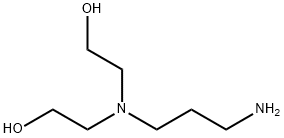General Description
A colorless liquid with a faint fishlike odor. May burn though AMINOPROPYLDIETHANOLAMINE(4985-85-7) may require some effort to ignite. Corrosive to tissue. Produces toxic oxides of nitrogen during combustion.
Reactivity Profile
AMINOPROPYLDIETHANOLAMINE is an aminoalcohol. Amines are chemical bases. They neutralize acids to form salts plus water. These acid-base reactions are exothermic. The amount of heat that is evolved per mole of amine in a neutralization is largely independent of the strength of the amine as a base. Amines may be incompatible with isocyanates, halogenated organics, peroxides, phenols (acidic), epoxides, anhydrides, and acid halides. Flammable gaseous hydrogen is generated by amines in combination with strong reducing agents, such as hydrides.
Air & Water Reactions
Water soluble.
Health Hazard
TOXIC; inhalation, ingestion or skin contact with material may cause severe injury or death. Contact with molten substance may cause severe burns to skin and eyes. Avoid any skin contact. Effects of contact or inhalation may be delayed. Fire may produce irritating, corrosive and/or toxic gases. Runoff from fire control or dilution water may be corrosive and/or toxic and cause pollution.
Fire Hazard
Non-combustible, substance itself does not burn but may decompose upon heating to produce corrosive and/or toxic fumes. Some are oxidizers and may ignite combustibles (wood, paper, oil, clothing, etc.). Contact with metals may evolve flammable hydrogen gas. Containers may explode when heated.
Uses
N-(3-Aminopropyl)diethanolamine acts as a potential coreactant for enhancing tris(2,2’-bipyridyl)ruthenium(II) electrochemiluminescence.
Flammability and Explosibility
Nonflammable
